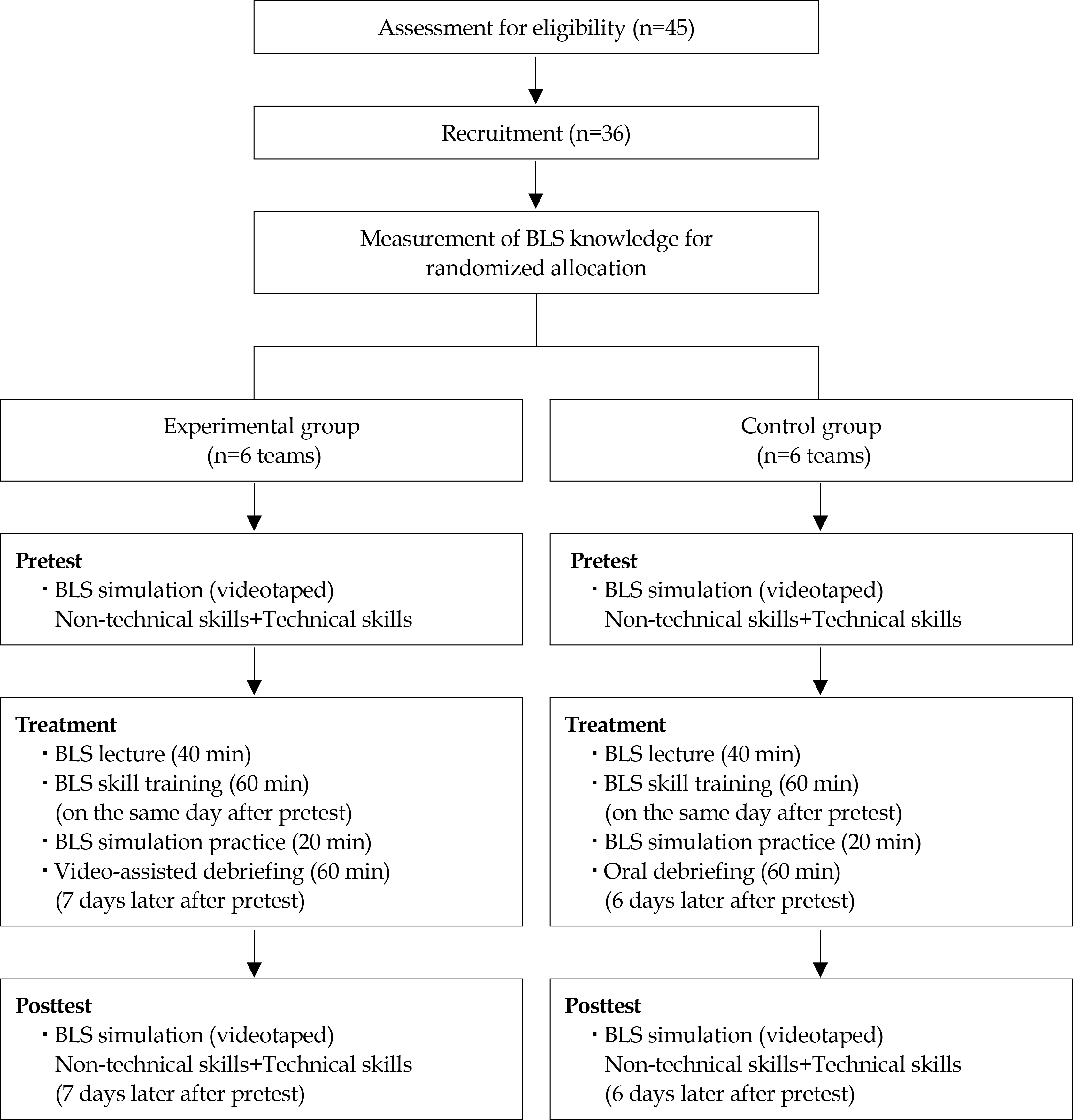1Wonju Severance Christian Hospital, Wonju
2Department of Nursing, Wonju College of Medicine, Yonsei University, Wonju, Korea
Copyright © 2016 Korean Society of Adult Nursing
This is an Open Access article distributed under the terms of the Creative Commons Attribution Non-Commercial License (http://creativecommons.org/licenses/by-nc/3.0) which permits unrestricted non-commercial use, distribution, and reproduction in any medium, provided the original work is properly cited.


Homogeneity Test of Dependent Variables
| Variables | Exp. (n=6) | Cont. (n=6) | U | p |
|---|---|---|---|---|
| M±SD | M±SD | |||
| Non-technical skills | 10.67±4.97 | 19.67±6.50 | -2.70 | .003 |
| Leadership | 2.33±2.07 | 4.00±1.41 | -1.62 | .134 |
| Teamwork | 7.17±2.40 | 10.17±4.96 | -1.33 | .212 |
| Task management | 1.17±1.17 | 5.50±0.55 | -2.93 | .003 |
| Technical skills | 27.83±8.42 | 30.33±6.02 | -0.32 | .720 |
| Check unresponsiveness | 3.10±0.75 | 3.67±0.81 | -1.82 | .110 |
| Call for help | 2.00±1.41 | 2.17±1.60 | -0.17 | .891 |
| Check pulse | 1.67±1.96 | 2.50±1.22 | -0.59 | .551 |
| Chest compression | 9.67±2.06 | 11.33±1.50 | -0.25 | .812 |
| Ventilation | 4.33±2.25 | 5.17±1.16 | -0.68 | .518 |
| Defibrillation | 3.33±2.65 | 2.67±2.06 | -0.33 | .711 |
| Recheck circulation | 0.67±0.81 | 0.67±1.63 | -0.86 | .420 |
| Integrity | 2.33±1.86 | 2.17±1.32 | -0.17 | .862 |
Exp.=Experimental group; Cont.=Control group.
Effects of Basic Life Support Simulation Training Using Video-assisted Debriefing on Non-technical Skills (N=12)
| Variables | Groups | Pretest | Posttest | Pre-Post | Mean difference | |||
|---|---|---|---|---|---|---|---|---|
| M±SD | U (p) | M±SD | U (p) | Z (p) | M±SD | U (p) | ||
| Non-technical skills | Exp. | 10.67±4.97 | -2.70 (.003) | 40.17±1.84 | -3.36 (.001) | -2.20 (.029) | -29.50±3.62 | -2.65 (.008) |
| Cont. | 19.67±6.50 | 28.00±8.67 | -2.03 (.045) | -8.33±10.05 | ||||
| Leadership | Exp. | 2.33±2.07 | -1.62 (.134) | 7.17±0.41 | -3.02 (.002) | -2.68 (.033) | -3.08±2.43 | -2.53 (.021) |
| Cont. | 4.00±1.41 | 5.33±0.82 | -1.63 (.129) | -1.33±1.63 | ||||
| Teamwork | Exp. | 7.17±2.40 | -1.33 (.212) | 25.00±1.55 | -2.83 (.018) | -2.98 (.021) | -12.58±7.32 | -2.01 (.007) |
| Cont. | 10.17±4.96 | 17.50±6.32 | -2.00 (.008) | -7.33±7.03 | ||||
| Task management | Exp. | 1.17±1.17 | -2.93 (.003) | 8.00±0.00 | -2.68 (.006) | -2.05 (.009) | -3.25±4.05 | -2.90 (.003) |
| Cont. | 5.50±0.55 | 5.17±1.94 | -0.53 (.872) | 0.33±1.96 | ||||
Exp.=Experimental group; Cont.=Control group.
Effects of Basic Life Support Simulation Training Using Video-assisted Debriefing on Technical Skills (N=12)
| Variables | Groups | Pretest | Posttest | Pre-Post | Mean difference | |||
|---|---|---|---|---|---|---|---|---|
| M±SD | U (p) | M±SD | U (p) | Z (p) | M±SD | U (p) | ||
| Technical skills | Exp. | 27.83±8.42 | -0.32 | 53.67±0.82 | -2.69 | -2.20 (.023) | -25.83±8.52 | -2.04 |
| Cont. | 30.33±6.02 | (.720) | 47.83±3.43 | (.006) | -2.20 (.022) | -17.50±5.58 | (.007) | |
| Check unresponsiveness | Exp. | 3.10±0.75 | -1.82 | 4.00±0.00 | 0.00 | -2.07 (.035) | -1.17±0.75 | -1.82 |
| Cont. | 3.67±0.81 | (.110) | 4.00±0.00 | (1.00) | -1.00 (.365) | -0.33±0.82 | (.111) | |
| Call for help | Exp. | 2.00±1.41 | -0.17 | 4.00±0.00 | 0.00 | -2.03 (.038) | -2.00±1.41 | -0.16 |
| Cont. | 2.17±1.60 | (.891) | 4.00±0.00 | (1.00) | -1.84 (.099) | -1.83±1.60 | (.894) | |
| Check pulse | Exp. | 1.67±1.96 | -0.59 | 3.67±0.52 | -0.56 | -1.76 (.117) | -2.00±2.09 | -0.89 |
| Cont. | 2.50±1.22 | (.551) | 3.50±0.55 | (.560) | -1.89 (.088) | -1.00±1.11 | (.398) | |
| Chest compression | Exp. | 9.67±2.06 | -0.25 | 13.33±0.52 | -2.71 | -2.21 (.019) | -3.67±1.86 | -2.02 |
| Cont. | 11.33±1.50 | (.812) | 12.00±0.63 | (.003) | -0.85 (.421) | -0.67±1.86 | (.045) | |
| Ventilation | Exp. | 4.33±2.25 | -0.68 | 5.67±0.52 | -0.19 | -1.41 (.221) | -1.33±2.42 | -0.54 |
| Cont. | 5.17±1.16 | (.518) | 5.50±0.84 | (.881) | -0.37 (.651) | -0.33±1.51 | (.555) | |
| Defibrillation | Exp. | 3.33±2.65 | -0.33 | 7.67±0.52 | -1.39 | -2.21 (.018) | -4.33±2.42 | -0.32 |
| Cont. | 2.67±2.06 | (.711) | 6.50±1.87 | (.250) | -2.02 (.041) | -3.88±2.79 | (.720) | |
| Recheck circulation | Exp. | 0.67±0.81 | -0.86 | 8.00±0.00 | -2.29 | -2.32 (.012) | -7.33±0.81 | -2.19 |
| Cont. | 0.67±1.63 | (.420) | 5.33±1.97 | (.013) | -2.21 (.021) | -4.66±1.97 | (.025) | |
| Integrity | Exp. | 2.33±1.86 | -0.17 | 7.33±0.52 | -1.99 | -2.21 (.019) | -5.00±2.19 | -2.19 |
| Cont. | 2.17±1.32 | (.862) | 6.00±1.67 | (.049) | -2.21 (.020) | -3.83±2.04 | (.025) | |
Exp.=Experimental group; Cont.=Control group.
Exp.=Experimental group; Cont.=Control group.
Exp.=Experimental group; Cont.=Control group.
Exp.=Experimental group; Cont.=Control group.